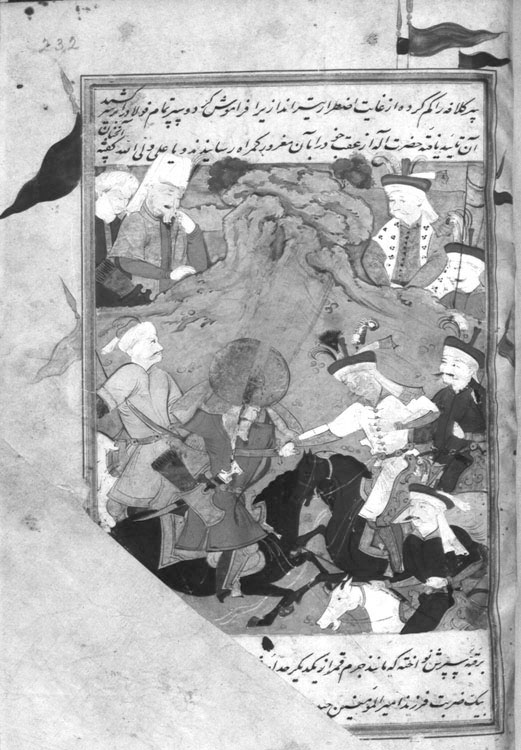Date of this event: 919/1513.
On 3 Ramażān 918/12 November 1512, the Safavid forces commanded by Emir Najm-e Sāni, the vakil-e divān-e aʿlā, were shattered in a devastating defeat at Ǧojdovān in Transoxiana by the combined forces of three Uzbeg sultans, ʿAbdollāh Ḵān, Jani Beg Soltān, and Moḥammad Timur Soltān. Following their victory, the Uzbeg sultans prevailed upon Qāsem Ǩān, the ruler of another branch of Uzbegs from Southern Russia, known as the Khanate of Qasemoff, to lend assistance in their plan to invade Khorasan (cf. Ms. M, folio 273v). In response Qāsem Ǩān sent a force commanded by his son Abuʾl Ḵeyr Ḵān, and together with the other Uzbeg sultans again crossed the Oxus resolved to subjugate Khorasan. When news reached the shah in Qom, he decided upon a second expedition to Khorasan. In one of the battles in this campaign, fought in 919/1513 Esmāʿil met in battle and killed Abuʾl Ḵeyr Ḵān, the son of Qāsem Ḵān. According to the text, Esmāʿil got the upper hand by emitting a scream so loud that Abuʾl Ḵeyr Ḵān became confused and forgot to shoot his arrow. This gave Esmāʿil the opportunity to reach him from behind; Abuʾl Ḵeyr Ḵān spun around but only had the chance to raise his shield over his head in desperation before the shah’s sword came crashing down.
Shah Esmāʿil, dressed in a white knee length coat with gold trim and Safavid tāj on his head, is represented in the lower right foreground astride a dark brown horse. With one mighty blow of his sword, he has managed to split his opponent, Abuʾl Ḵeyr Ḵān, in two parts vertically from head to waist. The force of the single blow is emphasized in that the shield held aloft by his opponent was insufficient to deflect the thrust, and it too has been severed in two pieces. Esmāʿil is flanked by two qezelbāš, and two others observe from behind the ridge in the upper right. The Uzbegs are represented by three personage in addition to Abuʾl Ḵeyr Ḵān. One, riding a white horse and carrying a standard, is drawn rather comically, his head turned completely to the rear as he moves forward out of the picture on the left side. The two remaining Uzbegs appear from behind a ridge in the upper left, the most prominent of which sports a goethe and makes a gesture of astonishment by raising his forefinger to his lip. Curiously enough, this individual is wearing the distinctive tall headdress of the Ottomans, which is totally incongruous with the event being depicted. The third Uzbeg is an individual of lesser rank, apparently a standard bearer. The composition is circular in form; the setting, as usual, is a sloping hillside that rises to a craggy rock formation at the top, with a slight suggestion of foliage.
Painting: 14.6 x 12.0 cm. Two lines of text above and below the painting. Frame encloses painting and text; seven standards protrude beyond the frame into the margins - two on each side, and three at the top. The page has been severely damaged in that the lower left corner was apparently at some time in the past folded on a diagonal, and that corner has subsequently been torn away and lost. This has resulted in a loss of half of the two bottom lines of text, and about 5% of the painting area. Apart from Esmāʿil’s face, which has suffered from abrasion, that portion of the painting that remains exhibits no further signs of major damage or retouching. Unsigned.
For two other variants of this subject also painted by Moʿin, see Ms. M, folio 280, and Ms. N, no. JK_463
Painting references:
Unpublished.
Text X-references:
See Muntaẓer-Ṣāḥeb_1970, pp.492-93 for this event in the History of Shah Esmāʿil.
See Savory, SA_1979, pp.66-67 for this event in the History of Shah ʿĀbbās.
Robert Eng
Last updated: November 24, 2010
